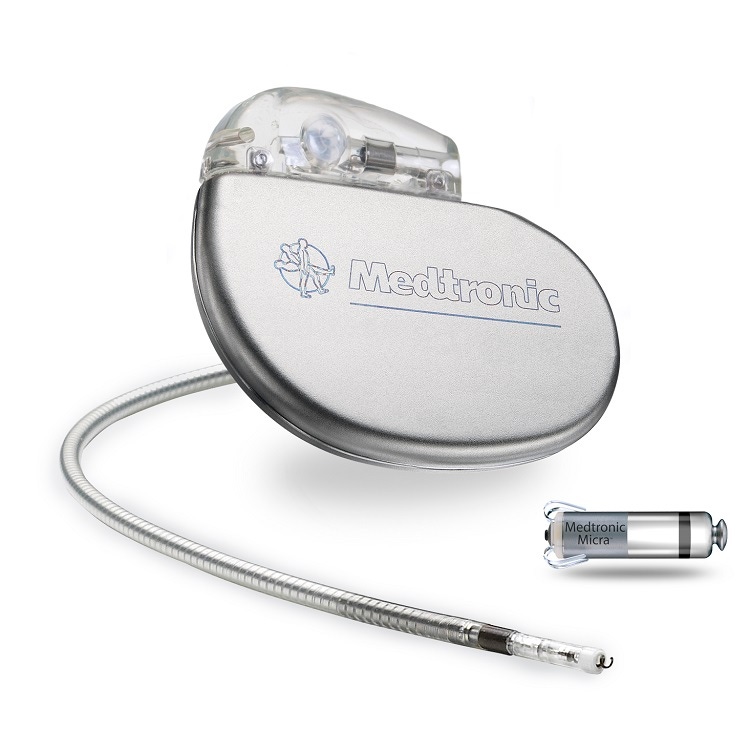Based on positive study results, Medtronic is seeking a PMA supplement from FDA to expand the use of Micra to patients with AV block and normal sinus rhythm. Micra, which is touted as the world's smallest pacemaker, was approved by FDA in 2016 for patients with atrial fibrillation or other dangerous arrhythmias such as bradycardia-tachycardia syndrome.
November 11, 2019

Study results published this week in the Journal of the American College of Cardiology: Clinical Electrophysiology show that an investigational set of algorithms in Medtronic's Micra transcatheter pacing system (TPS) significantly improves synchrony and cardiac function in patients with impaired electrical conduction between the chambers of the heart, a condition called atrioventricular (AV) block.
The results from the MARVEL 2 study are expected to be presented Nov. 16 at the American Heart Association's annual scientific sessions.
Medtronic said that based on positive results from both its MARVEL and MARVEL 2 studies, the company has submitted a PMA supplement to expand the indicated population of the Micra pacemaker to patients with AV block and normal sinus rhythm. Touted as the world's smallest pacemaker, Micra was the first leadless pacemaker to win FDA approval in 2016.
“While leadless pacing has many advantages compared to traditional pacemakers - including fewer infection-related complications - leadless pacemakers are currently only capable of single-chamber ventricular sensing and pacing,” said Larry Chinitz, MD, a co-principal investigator of the MARVEL 2 study, a cardiac electrophysiologist, and director of New York University's Langone’s Heart Rhythm Center. “Our investigation shows that accelerometer-based atrial-sensing algorithms can sense signals from the atrium in the heart and make calculated adjustments to when ventricular pacing occurs, thus improving coordination between the atrium and ventricle. These results provide further evidence that these novel investigational algorithms added to the Micra TPS may allow more patients, including those with normal sinus rhythm and AV block, to benefit from a leadless pacemaker.”
The MARVEL 2 study evaluated 75 patients with a Micra TPS at 12 centers in Hong Kong, Malaysia, Europe, and the United States. Investigators evaluated the safety and effectiveness of accelerometer-based atrial sensing algorithms, which were downloaded to the Micra TPS device. Forty patients had complete heart block and normal sinus rhythm and were eligible for inclusion in the primary efficacy analysis while all 75 patients were included in the primary safety objective. Investigators evaluated the ability of the Micra accelerometer to monitor and detect atrial contractions and enable coordinated pacing between the atrium and ventricle, thereby providing AV synchrony.
Using continuous device telemetry and an electrocardiogram Holter monitor, patients’ AV synchrony was measured during 20 minutes of rest and during single-chamber ventricular (VVI) pacing. The study’s primary efficacy objective was met, with a significantly greater percentage of complete heart block patients with normal sinus rhythm having >70% AV synchrony during algorithm-mediated AV synchronous pacing (38 of 40 patients, 95%) than VVI pacing (0 patients, P<0.001 for proportion of patients with >70% synchrony). The median percent AV synchrony was 94.3% during AV synchronous pacing compared to 26.9% during VVI pacing.
In addition, blood flow from the left ventricle (velocity time integral, a proxy for stroke volume), increased by 1.7 cm (on an absolute scale, 95% CI: 0.7-2.7cm, P=0.002; or 8.8% on a relative scale) during AV synchronous pacing compared with single-chamber ventricular pacing mode in patients with normal sinus rhythm with complete heart block.
The study’s primary safety objective was met, with no pauses or episodes of pacing-induced tachycardia reported during algorithm mediated AV synchronous pacing in any of the 75 patients.
“The results of MARVEL 2 build on the original promising MARVEL results and provide the strongest evidence to date that accelerometer-based atrial sensing with the Micra leadless pacemaker has the potential to provide improved AV synchrony in AV block patients, who make up approximately 40% of the pacemaker population worldwide,” said Rob Kowal, MD, PhD, chief medical officer, vice president of medical affairs in the Cardiac Rhythm and Heart Failure division, which is part of the Cardiac and Vascular Group at Medtronic.
About the Author(s)
You May Also Like




